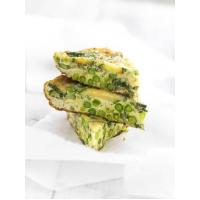High in protein and essential vitamins and minerals this is a perfect light lunch or supper – and it won’t taste the same without good olive oil. And its a healthy fat too!
When fresh peas are available this is a great way to eat them, thawed frozen peas can always be substituted. This frittata also tastes delicious if mint is added instead of tarragon. Note also that courgettes/zucchini are the same thing!
Zucchini and Pea Fritta from the experts at Filippo BerioServe 4-6
Preparation time : 10 minutes
Cooking time : 15-20 minutes
175g (6oz) freshly podded peas (about 450g in pod) or frozen, thawed
4 tbsp Filippo Berio Mild and Light Olive Oil
www.filippoberio.co.uk
1 small onion, finely chopped
3 medium courgettes, trimmed and thinly sliced
8 large eggs, beaten
2 tsp chopped fresh tarragon
2 tbsp freshly chopped parsley
25g (1oz) freshly grated Parmesan cheese
salt and freshly ground black pepper
Method:
1. If using freshly podded peas, drop them into a small pan of boiling water and cook 2 minutes then drain.
2. Heat a 23cm (9) non-stick frying pan and add the oil. Cook the onion for about 3-4 minutes over a medium heat until softened then add the courgettes. Fry the courgettes for 5 minutes or until they begin to soften. Meanwhile preheat the grill.
3. Add the drained peas and herbs to the pan.
4. Beat the eggs and season then pour over the vegetable. Reduce the heat and cook for about 5 minutes or until the eggs are almost set. Carefully lift and edge of the frittata with a palette knife to check the underside which should be golden.
5. Scatter the Parmesan cheese over the frittata and put under the grill for 1-2 minutes or until just set and golden.
6. Cut the frittata into wedges and serve warm or slide onto a plate and serve cold for a picnic with crusty bread.
For more information: www.fillipoberio.co.uk

